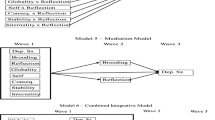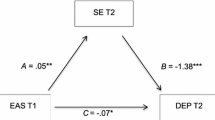Abstract
Depression increases sharply during adolescence. This study prospectively investigated etiological predictions from the hopelessness theory of depression (Abramson, Metalsky, & Alloy, 1989) among a sample of middle to late adolescents to examine whether this theory can be applied to this important age group. High school students completed measures of attributional style, hopelessness, negative stressors, general depressive symptoms, and specific hypothesized hopelessness depressive (HD) symptoms at two times separated by 5 weeks. Results showed that the attributional style × stress interaction predicted increases in depressive symptoms from T1 to T2. Gender moderated this interaction for the BDI such that the vulnerability–stress component held for boys, but not girls. Consistent with the vulnerability–stress component of the theory, these effects held for the increase in HD symptoms for both boys and girls, but not non-HD symptoms. Mediational analyses did not provide consistent support for hopelessness as a mediator of this association. These results were mostly the same whether the internal, stable, and global dimensions versus only the stable, global dimensions of attributional style were used to operationalize cognitive vulnerability. Overall, results suggest that the cognitive vulnerability–stress aspect of the hopelessness theory can be applied to middle to late adolescence.
Similar content being viewed by others
References
Abramson, L. Y., Metalsky, G. I., & Alloy, L. B. (1989). Hopelessness depression: A theory-based subtype of depression. Psychological Review, 96, 358–372.
Abramson, L. Y., Seligman, M. E. P., & Teasdale, J. (1978). Learned helplessness in humans: Critique and reformulation. Journal of Abnormal Psychology, 87, 49–74.
Achenbach, T. M., McConaughy, S. H., & Howell, C. T. (1987). Child/adolescent behavioral and emotional problems: Implications of cross-informant correlations for situational specificity. Psychological Bulletin, 101, 213–232.
Aiken, L. S., & West, S. G. (1991). Multiple regression: Testing and interpreting interactions. Newburg Park, CA: Sage.
Allgood-Merten, B., Lewinsohn, P. M., & Hops, H. (1990). Sex differences and adolescent depression. Journal of Abnormal Psychology, 99, 55–63.
Alloy, L. B., & Clements, C. M. (1998). Hopelessness theory of depression: Tests of the symptom component. Cognitive Therapy and Research, 22, 303–336.
Alloy, L. B., Just, N., & Panzarella, C. (1997). Attributional style, daily life events, and hopelessness depression: Subtype validation by prospective variability and specificity of symptoms. Cognitive Therapy and Research, 21, 321–345.
Angold, A., & Costello, E. J. (1993). Depressive comorbidity in children and adolescents: Empirical, theoretical, and methodological issues. American Journal of Psychiatry, 150, 1779–1791.
Baron, R. M., & Kenny, D. A. (1986). The moderator- mediator variable distinction in social psychological research: Conceptual, strategic, and statistical considerations. Journal of Personality and Social Psychology, 51, 1173–1182.
Beck, A. T., Steer, R. A., & Garbin, M. G. (1988). Psychometric properties of the Beck Depression Inventory: Twenty-five years of evaluation. Clinical Psychology Review, 8, 77–100.
Beck, A. T., Ward, C. H., Mendelson, M., Mock, J., & Erbaugh, J. (1961). An inventory for measuring depression. Archives of General Psychiatry, 4, 561–571.
Beck, A. T., Weissman, A., Lester, D., & Trexler, L. (1974). The measurement of pessimism: The Hopelessness Scale. Journal of Consulting and Clinical Psychology, 42, 861–865.
Birmaher, B., Ryan, N. D., Williamson, D. E., Brent, D. A., Kaufman, J., Dahl, R. E., Perel, J., & Nelson, B. (1996). Childhood and adolescent depression: A review of the past 10 years. Part I. Journal of American Academy of Child and Adolescent Psychiatry, 35, 1427–1439.
Cantwell, D. P., Lewinsohn, P. M., Rohde, P., & Seeley, J. R. (1997). Correspondence between adolescent report and parent report of psychiatric diagnostic data. Journal of American Academy of Child and Adolescent Psychiatry, 36, 610–619.
Cohen, J., & Cohen, P. (1983). Applied multiple regression/correlation analysis for the behavioral sciences (2nd ed.). Hillsdale, NJ: Erlbaum.
Cole, D. A., Peeke, L. G., & Ingold, C. (1996). Characterological and behavioral self-blame in children: Assessment and development considerations. Development and Psychopathology, 8, 381–397.
Compas, B. E., Davis, G. E., Forsythe, C. J., & Wagner, B. M. (1987). Assessment of major and daily stressful events during adolescence: The Adolescent Perceived Events Scale. Journal of Consulting and Clinical Psychology, 55, 534–541.
Coyne, J. C. (1994). Self-reported distress: Analog or ersatz depression? Psychological Bulletin, 116, 29–45.
Dixon, J. F., & Ahrens, A. H. (1992). Stress and attributional style as predictors of self-reported depression in children. Cognitive Therapy and Research, 16, 623–634.
Flett, G. L., Vredenburg, K., & Krames, L. (1997). The continuity of depression in clinical and nonclinical samples. Psychological Bulletin, 121, 395–416.
Ge, X., Lorenz, F. O., Conger, R. D., Elder, G. H., & Simons, R. L. (1994). Trajectories of stressful life events and depressive symptoms during adolescence. Developmental Psychology, 30, 467–483.
Gladstone, T. R., & Kaslow, N. J. (1995). Depression and attributions in children and adolescents: A meta-analytic review. Journal of Abnormal Child Psychology, 23, 597–606.
Gotlib, I. H., Lewinsohn, P. M., & Seeley, J. R. (1995). Symptoms versus a diagnosis of depression: Differences in psychosocial functioning. Journal of Consulting and Clinical Psychology, 63, 90–100.
Hammen, C., & Compas, B. E. (1994). Unmasking unmasked depression in children and adolescents: The problem of comorbidity. Clinical Psychology Review, 14, 585–603.
Hankin, B. L., & Abramson, L. Y. (1999). Development of gender differences in depression: Description and possible explanations. Annals of Medicine, 31, 372–379.
Hankin, B. L., & Abramson, L. Y. (2000). The Adolescent Cognitive Style Questionnaire: Reliability, validity, and gender differences. Manuscript submitted.
Hankin, B. L., Abramson, L. Y., & Angelli, N. (1999). A prospective test of hopelessness theory: Predicting different depression and anxiety constructs. Manuscript in preparation.
Hankin, B. L., Abramson, L. Y., Moffitt, T. E., Silva, P. A., McGee, R., & Angell, K. E. (1998). Development of depression from preadolescence to young adulthood: Emerging gender differences in a 10-year longitudinal study. Journal of Abnormal Psychology, 107, 128–141.
Hankin, B. L., Roberts, J., & Gotlib, I. H. (1997). Elevated self standards and emotional distress during adolescence: Emotional specificity and gender differences. Cognitive Therapy and Research, 21, 663–681.
Haslam, N., & Beck A. T. (1994). Subtyping major depression: A taxometric analysis. Journal of Abnormal Psychology, 103, 686–692.
Hilsman, R., & Garber, J. (1995). A test of the cognitive diathesis- stress model of depression in children: Academic stressors, attributional style, perceived competence, and control. Journal of Personality and Social Psychology, 69, 370–380.
Joiner, T. E. (2000). A test of the hopelessness theory of depression in youth psychiatric inpatients. Journal of Clinical Child Psychology, 29, 167–176.
Kashani, J., Reid, J. C., & Rosenberg, T. K. (1989). Levels of hopelessness in children and adolescents: A developmental perspective. Journal of Consulting and Clinical Psychology, 57, 496–499.
Kaslow, N. J., Rehm, L. P., & Siegel, A. W. (1984). Social- cognitive and cognitive correlates of depression in children. Journal of Abnormal Child Psychology, 12, 605–620.
Kaslow, N. J., Tannenbaum, R.L., & Seligman, M. E. P. (1978). TheKASTAN-R:Achildren's attributional style questionnaire (KASTAN-R-CASQ). Unpublished manuscript, University of Pennsylvania, Philadelphia, Pennsylvania.
Kazdin, A. E. (1994). Informant variability in the assessment of childhood depression. In W. M. Reynolds & H. F. Johnston (Eds.), Handbook of depression in children and adolescents (pp. 249–271). New York: Plenum Press.
Kazdin, A. E., French, N. H., Unis, A. S., Esveldt-Dawson, K., & Sherick, R. B. (1983). Hopelessness, depression, and suicidal intent among psychiatrically disturbed inpatient children. Journal of Consulting and Clinical Psychology, 54, 241–245.
Lewinsohn, P. M., Roberts, R. E., Seeley, J. R., Rohde, P., Gotlib, I. H., & Hops, H. (1994). Adolescent psychopathology: II: Psychosocial risk factors for depression. Journal of Abnormal Psychology, 103, 302–316.
McCauley, E., Mitchell, J. R., Burke, P., & Moss, S. (1988). Cognitive attributes of depression in children and adolescents. Journal of Consulting and Clinical Psychology, 56, 903–908.
Metalsky, G. I., & Joiner, T. E., Jr. (1992). Vulnerability to depressive symptomatology: A prospective test of the diathesis- stress and causal mediation components of the hopelessness theory of depression. Journal of Personality and Social Psychology, 63, 667–675.
Metalsky, G. I., & Joiner, T. E., Jr. (1997). The Hopelessness Depression Symptom questionnaire. Cognitive Therapy and Research, 21, 359–384.
Metalsky, G. I., Joiner, T. E., Jr., Hardin, T. S., & Abramson, L. Y. (1993). Depressive reactions to failure in a naturalistic setting: A test of the hopelessness and self-esteem theories of depression. Journal of Abnormal Psychology, 102, 101–109.
Monroe, S. M., & Simons, A. D. (1991). Diathesis-stress theories in the context of life stress research: Implications for the depressive disorders. Psychological Bulletin, 110, 406–425.
Nolen-Hoeksema, S., & Girgus, J. S. (1994). The emergence of gender differences in depression during adolescence. Psychological Bulletin, 115, 424–443.
Nolen-Hoeksema, S., Girgus, J. S., & Seligman, M. E. P. (1991). Sex differences in depression and explanatory style in children. Journal of Youth and Adolescence, 20, 233–245.
Nolen-Hoeksema, S., Girgus, J. S., & Seligman, M. E. P. (1992). Predictors and consequences of childhood depressive symptoms: A 5-year longitudinal study. Journal of Abnormal Psychology, 101, 405–422.
Panak, W. F., & Garber, J. (1992). Role of aggression, rejection, and attributions in the prediction of depression in children. Development and Psychopathology, 4, 145–165.
Petersen, A. C., Compas, B. E., Brooks-Gunn, J., Stemmler, M., Ey, S., & Grant, K. E. (1993). Depression in adolescence. American Psychologist, 48, 155–168.
Roberts, J. E., & Monroe, S. M. (1991). Vulnerable self-esteem and depressive symptoms: Prospective findings comparing three alternative conceptualizations. Journal of Personality and Social Psychology, 62, 804–812.
Robinson, N. S., Garber, J., & Hilsman, R. (1995). Cognitions and stress: Direct and moderating effects on depressive versus externalizing symptoms during the junior high transition. Journal of Abnormal Psychology, 104, 453–463.
Seligman, M. E. P., Peterson, C., Kaslow, N. J., Tanenbaum, R. L., Alloy, L. B., & Abramson, L. Y. (1984). Attributional style and depressive symptoms among children. Journal of Abnormal Psychology, 93, 235–238.
Spangler, D. L., Simons, A. D., Monroe, S. M., & Thase, M. (1993). Evaluating the hopelessness model of depression: Diathesis- stress and symptom components. Journal of Abnormal Psychology, 102, 592–600.
Sweeney, P. D., Anderson, K., & Bailey, S. (1986). Attributional style in depression: A meta-analytic review. Journal of Personality and Social Psychology, 50, 974–991.
Turner, J. E., Jr. & Cole, D. A. (1994). Developmental differences in cognitive diatheses for child depression. Journal of Abnormal Child Psychology, 22, 15–32.
Vredenburg, K., Flett, G. L., & Krames, L. (1993). Analogue versus clinical depression: A critical reappraisal. Psychological Bulletin, 113, 327–344.
Wagner, B. M., & Compas, B. E. (1990). Gender, instrumentality, and expressivity: Moderators of the relation between stress and psychological symptoms during adolescence. American Journal of Community Psychology, 18, 383–406.
Weishaar, M. E. (1996). Cognitive risk factors in suicide. In P. M. Salkovskis (Ed.), Frontiers of cognitive therapy (pp. 226–249). New York: Guilford.
Whisman, M. A., Miller, I. W., Norman, W. H., & Keitner, G. I. (1995). Hopelessness depression in depressed inpatients: Symptomatology, patient characteristics, and outcome. Cognitive Therapy and Research, 19, 377–398.
Whisman, M. A., & Pinto, A. (1997). Hopelessness depression in depressed inpatient adolescents. Cognitive Therapy and Research, 21, 345–358.
Author information
Authors and Affiliations
Rights and permissions
About this article
Cite this article
Hankin, B.L., Abramson, L.Y. & Siler, M. A Prospective Test of the Hopelessness Theory of Depression in Adolescence. Cognitive Therapy and Research 25, 607–632 (2001). https://doi.org/10.1023/A:1005561616506
Issue Date:
DOI: https://doi.org/10.1023/A:1005561616506




